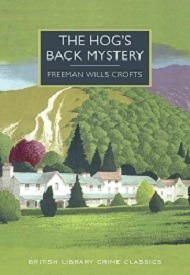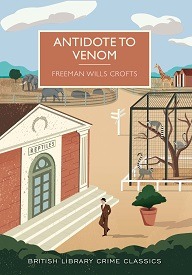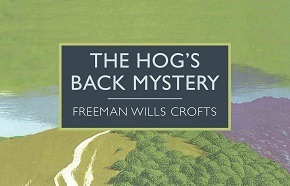Books
Freeman Willis Crofts and Classic Crime
The British Library’s series of Crime Classics has taken the publishing world by storm over the past eighteen months, with over a quarter of a million copies sold – in paperback alone! For many years, detective fiction written during “the Golden Age of murder” between the two world wars seemed deeply unfashionable. But you can’t beat a good story, and Agatha Christie was only one among scores of writers who wrote devilishly clever mysteries during the Twenties and Thirties.
The leading British crime writers of the day became members of the Detection Club, founded by Anthony Berkeley in 1930. Christie was a founder member, and so was Freeman Wills Crofts, an Irishman who worked for years as a railway engineer before finding fame with his first detective novel, The Cask. This book appeared in the same year as Christie’s debut, The Mysterious Affair at Styles – and was more immediately successful. Hard though it may seem to believe now, Crofts was for several years a more popular crime writer than Christie. His many fans even included T.S. Eliot, who was a passionate fan of the genre. The legendary Raymond Chandler, who could be harsh about traditional detective stories, called Crofts “the soundest builder of them all.”
 So it is fitting that the British Library should have republished two of his books – The Hog’s Back Mystery and Antidote to Venom. Their diversity is noteworthy. Crofts is sometimes regarded as a “one-trick pony”, someone whose novels always focused on breaking down an apparently watertight alibi. In fact, he realised the limitations of his original formula, and did his utmost to break away from it.
So it is fitting that the British Library should have republished two of his books – The Hog’s Back Mystery and Antidote to Venom. Their diversity is noteworthy. Crofts is sometimes regarded as a “one-trick pony”, someone whose novels always focused on breaking down an apparently watertight alibi. In fact, he realised the limitations of his original formula, and did his utmost to break away from it.
The Hog’s Back Mystery offers an ingenious murder puzzle set in Surrey, and demonstrates Crofts’ commitment to “playing fair” with his reader – to such an extent that, when Inspector Joseph French of Scotland Yard finally solves the mystery, the reader is reminded of each page where a clue was planted. “Cluefinders” were a popular feature of classic detective stories, reflecting the authors’ desire to set a tricky challenge for their readers to solve.
First published in 1938, Antidote to Venom is an ambitious and unusual detective novel. Crofts had been experimenting with his detective fiction, trying to escape from the predictable. Starting with The 12.30 from Croydon, which appeared in 1934, Crofts began to vary his approach, producing “inverted mysteries”, in which events are seen at first from the perspective of the culprit.
Antidote to Venom takes this method a stage further. The story benefits from an unusual setting – a zoo in the Midlands – and the central character is George Sturridge, eminently  respectable director of a major zoo. George’s marriage is far from happy, and due to a combination of his wife’s demands and his own gambling habit, he is short of money. He has an affluent, elderly aunt in poor health, and finds himself wishing that she will hurry up and die, so that he can inherit. When he starts a relationship with an attractive widow, his need for funds becomes acute, and seasoned mystery readers presume that Surridge will murder his aunt. However, Crofts cleverly confounds expectations with a series of cunning plot twists.
respectable director of a major zoo. George’s marriage is far from happy, and due to a combination of his wife’s demands and his own gambling habit, he is short of money. He has an affluent, elderly aunt in poor health, and finds himself wishing that she will hurry up and die, so that he can inherit. When he starts a relationship with an attractive widow, his need for funds becomes acute, and seasoned mystery readers presume that Surridge will murder his aunt. However, Crofts cleverly confounds expectations with a series of cunning plot twists.
Readers of Golden Age whodunits expect ingenuity, and Crofts delivers, not only with the murder method, but also with story structure. The first aspect of his experiment was the combination of the “inverted” narrative with an account of “direct” investigative work conducted by Crofts’ usual detective, Chief Inspector Joseph French of New Scotland Yard. French encounters a modus operandi so complicated and original – the zoo background is highly relevant – that Crofts supplied explanatory diagrams for the reader’s benefit.
And Crofts went further, and attempted something quite daring, and (so far as I know) unique among the work of leading detective novelists. As the story develops, it becomes clear that questions of morality and religious faith are at its heart. In Crofts’ terms, this was “an effort to tell a story of crime positively”.
Crofts showed from the outset of his literary career that the precision and discipline required of an engineer were invaluable qualities for a writer specialising in the construction of elaborate mysteries. He could certainly engineer a good plot, and it is a pleasure to see these two well-crafted back in print after many years’ absence from the shelves.
Martin Edwards is recognised internationally as an expert on Golden Age detective fiction and has written fascinating introductions to the British Library crime classics series. His new book, The Golden Age of Murder is a ground-breaking study of classic detective fiction written between the wars. To find out more about Martin, head over to his website.


Please note: Moderation is enabled and may delay your comment being posted. There is no need to resubmit your comment. By posting a comment you are agreeing to the website Terms of Use.